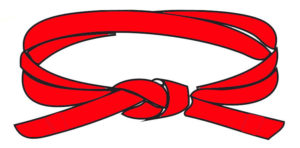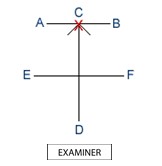Student Manual
You Are Here: Red Belt
Red Belt 2nd Kup
PATTERN – Hwa-Rang – 29 movements 
Hwa-Rang is named after the Hwa Rang youth group which originated in the Silla dynasty about 1350 years ago.
This group eventually became the actual driving force for the unification of the three kingdoms of Korea. The 29 movements refer to the 29th infantry division, where Tae Kwon- do developed into maturity.
New Techniques
- Close stance “c”
(Moa sogi “c”)
- Vertical stance
(Soo jik sogi)
- Palm pushing block
(Sonbadak miro makgi)
- Upwards punch
(Ollyo jirugi)
- Knife-hand downward strike
(Naeryo sonkal taerigi)
- Side front block
(Yop Ap makgi)
Power Test Techniques
1: Knife-hand strike to target at 45 degree angle
2: Left and Right turning kick to target at 45 degree angle
Power Tests are judged on
1: Proper technique
2: Correct striking tool
3: Proper posture
4: Accuracy
5: Destruction of target
Free Sparring – Jayu Matsogi
Attacking and Defending
(Free sparring is not prearranged. There is no prescribed number of steps or movements. It is essentially open combat with controlled attacks using all available means and methods.)
In order to prevent injury, protective equipment is worn. The teaching of free sparring starts at yellow belt, mainly for competitions.
Evaluation of free sparring is based on accuracy, speed, timing, distance, and quality of technique executed. Balance, blocking and dodging skills, and attitude are also very important.
Because each of the participants is free to move and attack, free sparring encourages the development of strategies for attack and defence, while improving speed and timing. Since free sparring is practiced as a non-stop fight that may consist of one or more rounds, and vary from short rounds of 30 seconds up to several minutes, being in good physical condition is very important.
Pattern: Hwa-Rang

Hwa-Rang
Movements – 29
Ready Posture – CLOSED READY STANCE C
1. Move the left foot to B to forma sitting stance toward D while executing a middle pushing block to D with the left palm.
2. Execute a middle punch to D with the right fist while maintaining a sitting stance toward D.
3. Execute a middle punch to D with the left fist while maintaining a sitting stance toward D.
4. Execute a twin forearm block while forming a left L-stance toward A, pivoting with the let foot.
5. Execute an upward punch with the left fist while pulling the right side fist in front of the left shoulder, maintaining a left L-stance toward A.
6. Execute a middle punch to A with the right fist while forming a right fixed stance toward A in a sliding motion.
7. Execute a downward strike with the right knife-hand while forming a left vertical stance toward A, pulling the right foot.
8. Move the left foot to A forming a left walking stance toward A while executing a middle punch to A with the left fist.
9. Move the left foot to D forming a left walking stance toward D while executing a low block to D with the left forearm.
10. Move the right foot to D forming a right walking stance toward D while executing a middle punch to D with the right fist.
11. Pull the left foot toward the right foot while bringing the left palm to the right forefist, at the same time bending the right elbow about 45 degrees outward.
